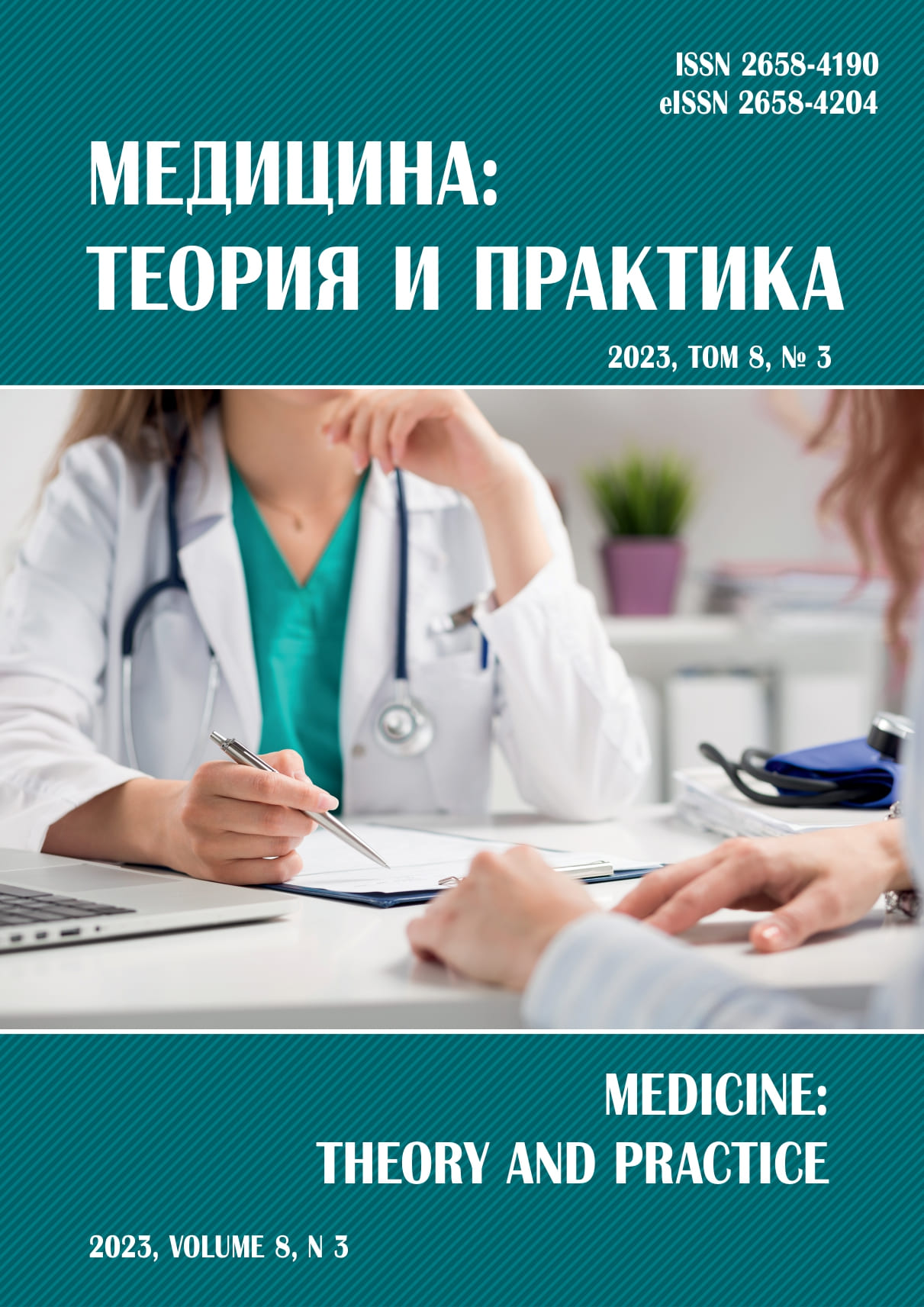THE ROLE OF STRUCTURAL AND FUNCTIONAL DISORDERS OF THE VASCULAR WALL IN THE DEVELOPMENT OF METABOLIC SYNDROME IN YOUNG MEN WITH ABDOMINAL OBESITY
Abstract
Background. The study of the structural and functional state of the vascular wall is important for understanding the mechanisms of early transformation of abdominal obesity into metabolic syndrome in young men of military age. Aim. To determine the significance of structural and functional disorders of the vascular wall in the development of the metabolic syndrome in young men aged 18‒21 years with abdominal obesity. Materials and methods. we examined 221 males aged 18−21 years with abdominal obesity (mean age 19.4 ± 1.2 years). Results. A decrease in endotheliumdependent vasodilation (EDV) by 2.47 times increases the risk of metabolic syndrome (RR = 2.47; 95 % CI 1.72–3.54) compared with young men without EDV impairment. An increase in vascular wall stiffness 4 times increases the risk of metabolic syndrome compared with young men with normal vascular wall stiffness (RR = 4.03; 95 % CI 2.3–7.06). In young men with an increased biological age of the vascular wall, the relative risk of metabolic syndrome is 10 times higher than in young men with a normal index (RR = 10.31; 95 % CI 3.41–31.16). An increase in the level of circulating endothelial cells in the peripheral blood 30 times increases the risk of metabolic syndrome compared with young men without such abnormalities (RR = 30.0; 95 % CI 4.29–42.61; p < 0.001). Against the background of hyperhomocysteinemia, the relative risk of metabolic syndrome is 14.8 times higher than in young men with a normal level of the indicator (RR = 14.84; 95 % CI 4.87–45.13; p < 0.001). ROC-analysis showed that of all the studied indicators, EDV has the highest prognostic value in predicting the metabolic syndrome in young men with abdominal obesity (area under the curve 0.96). Conclusions. Structural and functional disorders of the vascular wall significantly increase the risk of metabolic syndrome in young men with abdominal obesity.
References
Авдеева М.В. Комплексная оценка факторов кардиоваскулярного риска с использованием ресурсов Центра здоровья. Кардиоваскулярная терапия и профилактика. 2012; 11 (3): 47‒52.
Авдеева М.В., Орёл В.И., Щеглова Л.В. Медико-социальная характеристика популяционных групп с факторами кардиоваскулярного риска, обследованных в Центре здоровья. Бюллетень НЦССХ им. А.Н. Бакулева РАМН. 2011; 12 (5): 77‒84.
Бочарова О.В., Теплякова Е.Д. Ожирение у детей и подростков — проблема здравоохранения XXI века. Казанский медицинский журнал. 2020; 101(3): 381–8.
Галенко А.С., Захаров Д.В., Лосева К.А. Роль и функции эндотелия — краткая характеристика вопроса и вклад отечественных ученых в его изучение. Университетский терапевтический вестник. 2020; 2(2): 46–54.
Дедов И.И., Шестакова М.В., Мельниченко Г.А. Междисциплинарные клинические рекомендации. Лечение ожирения и коморбидных заболеваний. Ожирение и метаболизм. 2021; 18 (1): 5‒99.
Иванов Д.О., Успенский Ю.П., Барышникова Н.В. и др. Распространенность избыточной массы тела и ожирения у детей и подростков в Санкт-Петербурге: оценка рисков развития метаболического синдрома. Педиатр. 2021; 12(4): 5–13. DOI: 10.17816/PED1245-13.
Парфёнов А.С. Экспресс диагностика сердечно-сосудистых заболеваний. Мир измерений. 2008; 6: 74–82.
Рекомендации по ведению больных с метаболическим синдромом. Клинические рекомендации. М.: Российское медицинское общество по артериальной гипертонии; 2013: 1–43.
Самошкина Е.С., Балыкова Л.А., Широкова А.А. и др. Метаболический синдром у детей и подростков: современное состояние проблемы. Педиатрия. Журнал им. Г.Н. Сперанского. 2022; 101 (6): 138–45.
Строев Ю.И., Чурилов Л.П., Бельгов А.Ю., Чернова Л.А. Ожирение у подростков. СПб.: Медкнига ЭЛБИ; 2003.
Трашков А.П., Брус Т.В., Васильев А.Г. и др. Эндотелиальная дисфункция в патогенезе неалкогольной жировой болезни печени у крыс и методы ее коррекции. Russian Biomedical Research. 2017; 2(4): 11–7.
Церцвадзе Л.К., Авдеева М.В., Щеглов Д.С., Василенко В.С. Уровни биомаркёров эндотелиальной дисфункции у юношей 18 лет — 21 года с абдоминальным ожирением. Медицина: теория и практика. 2022; 7 (4): 45–51.
Celermajer D.S., Sorensen K.E., Spiegelhalter D.J. et al. Aging is associated with endothelial dysfunction in healthy men years before the age-related decline in women. J. Am. Coll. Cardiol. 1994; 24: 471‒6.
Corrigan F.E., Kelli H.M., Dhindsa D.S. et al. Changes in truncal obesity and fat distribution predict arterial health. J. Clin. Lipidol. 2017; 11: 1354–60. DOI: 10.1016/j.jacl.2017.08.013.
Dimitriu A. Cardiovascular risk factors in childhood obesity. Archives of Cardiovascular Diseases Supplements. 2022; 14 (1): 133−4.
Drozdz D., Alvarez-Pitti J., Wójcik M. et al. Obesity and cardiometabolic risk factors: from childhood to adulthood. Nutrients. 2021; 13 (11): 4176. DOI: 10.3390/nu13114176.
Nogueira M.D., Braga R.A., Manios Y. et al. New indices in predicting cardiometabolic risk and its relation to endothelial dysfunction in adolescents: the HELENA study. Nutrition, Metabolism and Cardiovascular Diseases. 2023.



